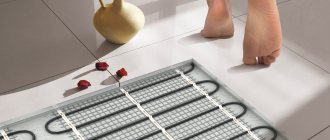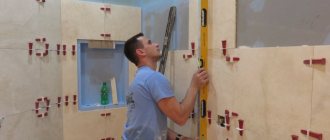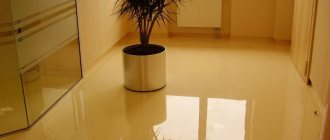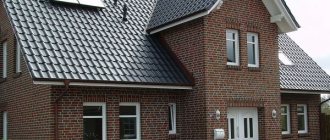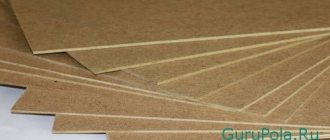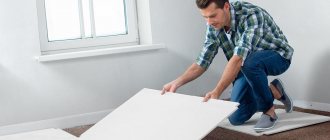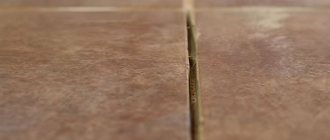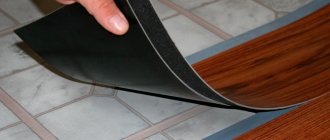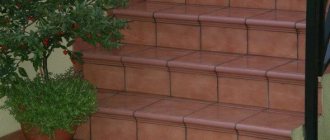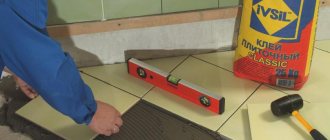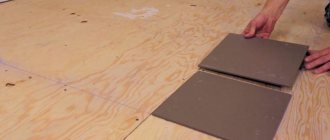Beton-House.com
Website about concrete: construction, characteristics, design. We combine the experience of professionals and private craftsmen in one place
The process of laying tiles on concrete
Concrete surfaces are an excellent basis for almost any finishing, as they have high strength, adhesion and a rough structure. This is especially good for materials laid using the adhesive method.
However, the surface of concrete can be different, depending on what type of concrete we are dealing with in a particular case. Let's figure out today how tiles are laid on a concrete base. We will mention both working with ceramics and other options.
What is the difference between Betonokontakt and quartz primer?
The Betonkontakt primer contains much more binders, but much less pigments, unlike quartz primer. The fraction of the same filler (quartz sand) in the Betonkontakt primers is from 0.3 to 0.6 mm, there are quartz primers with a finer filler, 0.2 mm for example.
Interesting materials:
How much does 1 meter of stretch ceiling cost? How much does IQOS cost in Italy? How much does the bus cost to Rosa Khutor? How much does gasoline cost per liter in America? How much does an hour for a teacher cost? How much does a cup of Luwak coffee cost in Moscow? How much does dextrose cost? How much does a high-tech house cost? How much does a kitchen apron cost? How much does Gaba cost?
Frequently asked questions about concrete contact
How to apply concrete contact to a wall?
To apply primer to walls, it is recommended to use a paint roller, and in places where a roller cannot reach, a brush is used. Some experts recommend spraying it with a simple primer. You cannot do this with concrete contact!
If the task is to prepare painted walls for laying tiles, then concrete contact will be the optimal solution. If the paint adheres confidently to the walls, then you can safely apply a primer over it without fear of peeling in the future.
Service life and storage conditions of concrete contact
The service life of concrete contact is approximately eighty years, which is quite an impressive figure. If we draw analogies, then roofing, tiles, stone, etc. will last you much less.
Concrete contact can be stored for a year and only in a room with above-zero temperatures. Be sure to make sure the lid is sealed tightly. If the solution comes into contact with air for a long time, it will become unusable. Everything else is not scary. The main thing is, after long-term storage, thoroughly stir the primer until it becomes homogeneous.
We tried to cover the topic in as much detail as possible. If you liked the article, then tell your friends about it and subscribe to updates!
Laying new tiles directly on old ones: a proven method
Is it possible to lay tiles on tiles? This question cannot be answered unequivocally. Because in rare cases you can be sure that the existing ceramics will hold tightly, have no voids and will not begin to fall off under the weight of the new tile.
Weigh the pros and cons and study the surface
In practice, you can put new tiles on top of old ones. But before installation, you should still weigh the pros and cons, and if, for some reason, you decide not to dismantle the previous coating, you need to carefully check whether it has a sufficiently reliable adhesion to the surface of the wall or floor. To do this, tap the tiles with a hammer and inspect them. If it rattles when tapped or has cracks and swellings, then there is no way to put a new layer on it. It will have to be dismantled. If the elements hold tightly, then you can begin work on laying new tiles.
Simple and reliable installation technology
The methods that craftsmen use when laying new ceramic tiles on old ones vary. Many people advise making notches, cutting off the glaze with a grinder, etc. But if you use a special primer, then all these measures will be unnecessary. Concrete contact is exactly what is needed for surfaces with low water absorption.
Before applying primer to old tiles, it is thoroughly cleaned of dirt and grease. Concrete contact is applied with a roller or brush. The material is thoroughly mixed before use and during operation. Do not allow the primer to get into your eyes, but if the mixture gets into your eyes, wash it off with plenty of water.
You need to wear rubber gloves when working with concrete contact. The average primer consumption is 300 g per m².
They produce acrylic-based concrete contact. In addition to special fillers that increase the adhesion of the mixture, the soil contains sand and cement. Any hard-to-absorbent surfaces can be treated with concrete contact. After applying primer to the surface, it becomes rough. When the previous coating is processed, it is given three hours to dry.
After the primer has dried, the surface is suitable for laying new material on the adhesive solution. Read more about how to do this here.
: work technology
Do not forget that if you do not remove the old tiles and lay new ones on them, this will reduce the area of your room. Bathrooms in apartments tend to have a small area, so it’s worth considering whether you need to reduce it even more.
***
© 2012-2020 Question-Remont.ru
Loading…
Display all materials with the tag:
Source: https://vopros-remont.ru/obshhie-voprosy/mozhno-li-klast-plitku-na-plitku/
When can further work be carried out?
The solution dries quite quickly - about 5 hours, some brands even faster - from 3 hours.
But experienced craftsmen allow more time for drying, applying the solution in the evening and leaving it overnight. Concrete contact is a unique primer coating with a “narrow specialization”. The cost is higher than for other types of primers, so before purchasing you should carefully read the information on the packaging and consult with more experienced professionals about the application in a particular case. Such caution will allow you not to spend too much and save on other repair needs.
Manufacturers you can trust
Before purchasing a deep penetration concrete contact primer, you should first decide on the manufacturer of the product. There are products from different companies on the market, but not many have earned the trust of customers. In order for the repair to be successful, and for the concrete contact to properly perform its intended functions, preference should be given to the products of the following manufacturers:
Knauf production plant
The company was founded in 1932 by two brothers Karl and Alfons Knauf. The main office is located in Germany. The company specializes in the production of building products - cladding, external insulation systems, building materials for suspended ceilings. This manufacturer is among the leaders in the production of soil.
Ceresit
The history of the company dates back to 1906, and the production of hermetic components, concrete and sand products began in 1908. Over the course of its existence, the company has opened many divisions in different countries. Ceresite is still popular in the construction industry today due to its high technical characteristics of the product. In addition, the products are affordable.
Feidal
This is one of the European leaders in the production of paint and varnish coatings. Several countries are involved in the development of the company: Poland, Germany, Russia and Ukraine. Thanks to this, products in the CIS countries are sold at an affordable price. The entire range is made taking into account the requirements of GOST, therefore it has a certificate of quality conformity.
VIDEO: How to use concrete contact
The best concrete contact primer for interior finishing
There is a wide range of deep penetration soil on the market. Thanks to the wide selection, each consumer will be able to choose the most suitable option for wall or ceiling treatment. Based on reviews from experienced builders, a rating of the product with the best performance characteristics was formed:
Knauf Betokontakt
An acrylic-based adhesive dispersed mixture is used for the initial treatment of cement plaster or concrete, onto which the subsequent application of gypsum plaster is planned. In addition, this mixture can be used to process cladding made of Knauf sheets, expanded polystyrene and interior walls and ceilings.
Available with mineral filler of two fractions, which affects the scope of application of the composition:
- 0.6 mm – before rough leveling the surface with a thick layer;
- 0.3 mm – for preparing already plastered and cleaned surfaces before puttying.
Application occurs on the cleaned surface in an equal layer. The manufacturer strictly prohibits applying the consistency to a frozen base. The component requires operation at temperatures above +5°C. In addition, the surface must be cleaned and thoroughly dried. The product is packaged in containers with a volume of 5 to 20 liters.
Brief characteristics and cost:
In containers of 5 and 20 kg.
Price for maximum volume, rub.
Concrete contact "Prospectors"
This is a deep penetration soil mixture with a depth of up to 5 mm, which contains acrylic as the main component. Used exclusively for interior work. It has a high level of antisepticity, resistance to moisture, and gas permeability. There are no toxins in the composition, so the consistency does not emit a chemical odor.
Prospector is used for pre-treatment of the surface before facing with paint, putty, plaster, wallpapering or laying tiles. It is successfully used in combination with concrete, gypsum, plasterboard, brick, wood building materials, and plaster. The primer consumption per 1 m2 is only 200 ml. Work with the product is permitted at air temperatures from +5°C to +30°C. It takes 1 hour for complete drying.
The product does not require preliminary preparation or stirring; just shake the container and apply it using a large roller, brush or spray. The material contains microscopic particles that fill microcracks, thereby increasing the service life. The cost of building materials is 500 rubles per 10 liters.
Ceresit CT 19
Adhesive Ceresit CT 19 Betonkontakt is used for preliminary preparation of dense and non-moisture-absorbing surfaces for cladding in order to increase the degree of adhesion to the base of finishing coatings. The following can be used as cladding:
- plaster;
- paint and varnish coatings;
- putty;
- adhesive composition for ceramic tiles.
The main features of the building material include a high level of resistance to moisture. In addition, when applied, a rough surface is created and the connection between the base and the finish is increased. The product is very effective when tiling using the tile-to-tile method. It is considered universal, therefore it is successfully used for both internal and external work.
Brief technical specifications:
Operating temperature, ºС
The cost of Ceresit ST-19 4.5 kg is about 650 rubles.
The best concrete contact primer for exterior finishing work
The adhesive mixture for the outside of the walls has slightly different technical parameters, since the surface is exposed to precipitation and other negative factors. Variations of the universal type may also be found on sale. The best include:
Bergauf Beton Contact
The adhesive composition is available in two different volumes: 7 and 14 kg. The first option costs 375 rubles, the second - 1250. A domestic manufacturer produces a pink soil component, which is used at temperatures from +5 to +25 ºС. The product does not require a three-hour waiting period; it only requires 50-60 minutes to dry completely. Primer consumption per 1 m2 of wall does not exceed 300 ml.
Bergauf Beton Contact
The material is used to process the following types of base:
- concrete;
- aerated concrete;
- drywall;
- reinforced concrete;
- plaster;
- Oil paint;
- tile.
First, the base is cleaned of defects, cleaned of dust, dirt, and grease.
Recommendations for surgery
In order to do the job flawlessly on the first try, it is better to listen (heed?) to the advice that masters share with beginners.
Purchase and preparation of the composition
- Buying a quality product that has many positive reviews is the only way to protect yourself from all kinds of counterfeits. Checking the packaging (expiration date) and quality certificate “without leaving the checkout” will give you a chance to purchase a fresh and efficiently working product.
- If you are not sure which primer is needed for a particular surface, then it is better to get all the information from sales consultants. They will lay out all the necessary information - about the manufacturer, about the concrete contact: consumption, features of the types available for sale.
- After opening the package, the primer, which is similar in consistency to paint, is also thoroughly mixed, for example, with a mixer attachment. An obstacle to applying concrete contact is a high level of humidity (more than 75%). It will not allow the material to dry “correctly”.
The homogeneity of the mixture is the first sign of a quality product. Any lumps in a freshly opened container indicate the opposite.
Surfaces and work
Betonokontakt does not like greasy stains on the paint, so problem areas are washed (wipe) with a sponge, then degreased. The use of a regular primer will allow you to slightly reduce consumption, since it will do its job - it will fill all the cracks in the base. Large and small debris, dirt, unevenness or suspicious areas that threaten to soon crumble are the obstacles that will have to be gotten rid of. A necessary condition for work is a clean but completely dry base. Surfaces that absorb liquid well are a sufficient reason to apply two layers of concrete contact. If the base has serious defects or unusual relief, then re-processing of this problematic surface is also required. The tool is selected based on convenience and surface area. It can be a roller, brush, spray gun
In the latter case, it is important that the size of the nozzle does not interfere with the exit of the mixture components. Wide brushes are ideal
Rollers, on the contrary, increase consumption by absorbing a large amount of the composition. Mandatory drying of each layer, regardless of their number, is a rule that applies to almost all construction work. However, you should not hesitate to fix the finishing material onto the last dried layer. Otherwise, enough dust will settle on it, and it will reduce the contact strength. Protection of the base from it is necessary. If 48 hours have passed after applying the concrete contact, then a new surface treatment will be required: this time with ordinary deep penetration soil.
If not all of the concrete contact is used, then the packaging is stored at room temperature. Sending it to “winter” on an open balcony is prohibited: since after freezing the primer loses its unique properties. The shelf life of the material is from 6 to 12 months.
Expert advice
When priming walls with concrete contact primers, there are several nuances that home craftsmen need to know.
1. Deep penetration compounds, which are applied first, will help reduce the consumption of expensive primer by 30-40%. In this case, porous substrates need to be applied 2-3 times, which will allow you to get by with just one layer of “Betonkontakt”.
2. You cannot prime:
3. When applying plaster, the solution should not be more liquid than required by the technology. It will fall off over time.
4. After the primer has dried, you must immediately begin further work. After just 2 days, the surface becomes unsuitable for applying plaster solutions or tile adhesive due to adhering dust. Needs re-processing.
5. The point follows from the previous one - you need to prime such a surface area that can be plastered or tiled within 1-2 days.
6. Beware of fakes. Don’t be lazy to ask the seller for a certificate of conformity.
7. Do not speed up the drying process with intensive ventilation or heat guns - the polymerization process is disrupted. As a rule, this does not lead to good.
Subtleties of application
Before covering the surface with Betokontakt primer, it should be carefully prepared. To do this, it is cleaned of debris and dust manually or using a construction vacuum cleaner. Before application, the composition is thoroughly mixed, preferably using a construction mixer, so that the fine sand is evenly distributed in the primer. Under no circumstances is it recommended to dilute the composition with water, as this will cause it to lose all its properties. However, some manufacturers allow the composition to be diluted with a small amount of water in order to save money.
When working with Betokontakt Knauf primer, the following rules must be observed:
- the temperature in the room where the work will be carried out should be in the range from +3 to +30 degrees;
- air humidity should not exceed 75%;
- subsequent work can be carried out only after the primer has completely dried, that is, after 12–15 hours.
After applying Betokontakt, it is necessary to check the quality of the coating. This is necessary in order to notice defects in the primed surface in time and eliminate them to ensure good adhesion. To do this, you need to run a metal or rubber spatula over the dried soil and look at the crumbling of sand particles. If they are easily and in large quantities removed from the surface, then such a coating cannot be called high-quality, and finishing materials will not adhere well to it.
Betokontakt Knauf is a primer that allows you to prepare many surfaces for finishing, including metal, plasterboard and other materials. The main thing is to follow the manufacturer’s recommendations and application technology, as well as to prepare the surface to be treated well.
In the next video you will see an overview of the Knauf Betokontakt primer.
Methods for laying tiles on tiles
Many owners of apartments and houses who decide to do their own renovations often wonder whether the old layer of tile can serve as a basis for laying new tiles. It turns out that it is possible and there are some ways to lay tiles on tiles that will significantly save time on renovation work, especially in the bathroom or kitchen. Although this may also apply to other surfaces lined with tiled material. For example: floors, building facade, fence, paths, etc. We will give several such methods.
- Evaluation of the old layer.
- Removing the glossy surface.
- Notches on the tiles.
- Drilling tiles.
- Application of Concrete Contact.
Old layer evaluation
Before deciding to lay tiles on tiles, it is necessary to evaluate the old layer of tiles, because without this, all subsequent actions will not bring the desired result.
There are several criteria for determining the suitability of the base for new tiles:
- When tapping, the old tiles are not destroyed and the sound from tapping is uniform.
- If the main tile has many small cracks, it will have to be removed.
- There are no communications under the old tiles.
- If there is no slope on the tiled floor.
Removing the glossy surface
One way to install tiles on tiles involves removing the glossy surface from the old tiles. Of course, provided that the tile holds well and there are no voids in the layer, since deglazing is done using a grinder and a concrete disc. During the removal process, the surface layer of old tiles experiences heavy loads.
In addition, this method is labor-intensive and occurs when a large amount of dust is generated. But it will still take less time, labor and dirt than dismantling all the old tiles. After the glossy layer has been removed, a new layer of ceramic tiles is laid using conventional technology.
Specifications
The finished primer is a viscous liquid, usually pinkish in color. It has the following characteristics:
- Special adhesive additives in the concrete contact composition allow it to firmly bond even to the most problematic and dusty surfaces.
- Quartz sand increases the adhesion of the product to cement or wood, and also forms a rough layer with high adhesion on the treated surface.
- Biocidal additives prevent materials from being damaged by bacteria or mold.
- Durability of the composition. According to manufacturers, primer applied to various substrates can retain its properties for several decades.
- Waterproof. Can perform the function of waterproofing.
Why do you choose Betonokontakt?
Changing characteristics include soil consumption and the rate of drying. The first indicator depends on the type of primer and the characteristics of the surface on which it is applied. Concrete contact consumption per 1 m2 ranges from 200 to 400 grams. The answer to the question of how long it takes Concrete Contact to dry depends on the temperature and humidity conditions in the room (on average 3-4 hours).
